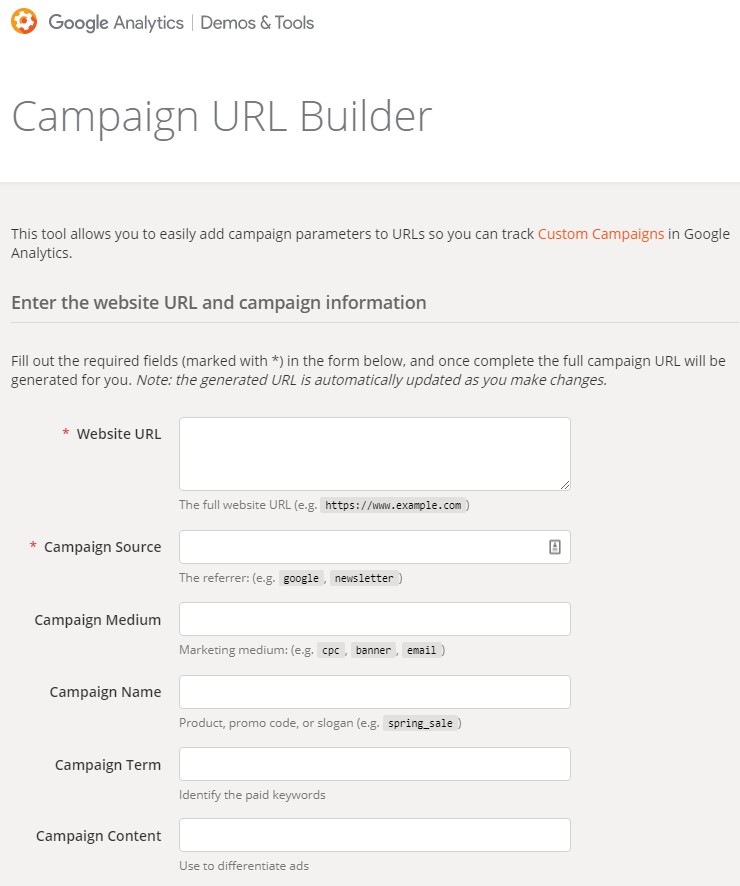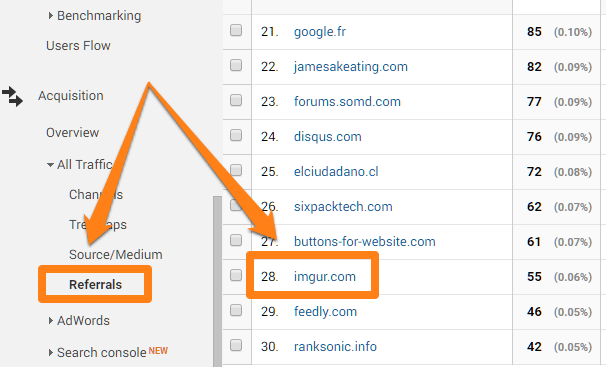In this article, we will talk about how you can track the conventional marketing through the internet using UTM tracking, and how useful it will be in digital marketing.
Now let’s discuss, what are UTM tracking codes?
Table of Contents
What are UTM codes?
UTM codes are snippets of text added to the end of a URL to help identify and track where websites traffic comes from if the user clicks a link to the URL. Marketers can customize the text to match the webpage the URL is linked to, enabling them to attribute the success of that campaign to particular portions of the content.
UTM codes also are known as UTM parameters or tracking tags as they help in tracking website traffic from its origin.
UTM stands for Urchin Traffic Monitor. There are 5 variants of URL parameters that you can track – source, medium, campaign, term, and content. The dimension you track through UTM codes displays in your analytics reports to give a better insight into marketing performance.
A UTM code looks similar to this:
http://yourwebsite.com/your-post-title/?utm_source=google
The part in red starting after ‘?’ is the UTM code. This selective code tracks who sent the traffic to the page.
The UTM tracking code itself has two parts:
- UTM parameter: Starts with utm_. There are 5 separate parameters that you can track: utm_source, utm_campaign, utm_content, utm_term.
- Tracking variable: A distinct variable to spot the dimension being tracked. This variable is followed by the ‘=’ sign. You can have only numbers, letters, hyphens, ‘+’ sign, and periods in the variable.
UTM tracking codes can be long and complex. Adding the UTM tracking code doesn’t impact the original page. You can delete the UTM tracking code from the URL and the page would load normally.
What can you track with UTM tracking codes?
There are five distinct UTM tracking parameters. Generally, 3 of them are the most used parameters (Source, Medium Campaign). However, for extra insights, you need to pick to track all 5. Below I have shown what you can track with each of the 5 parameters:
Traffic Source
The source parameter enables you to trace from traffic origination. The parameter added to your URL is utm_source. Sources that you may track can be Facebook, bing, google, name of an email list.
Example: &utm_source=twitter
Medium
The medium parameter traces what kind of traffic the visitor originated from CPC, email, referral, social, display, etc. The parameter is utm_medium_
Example: &utm_medium=cpc
Campaign Name
The campaign name parameter enables you to trace the performance of a particular campaign. For instance, you can utilize the campaign parameter to distinguish traffic among Facebook Ad campaigns or email campaigns. Below is the utm_campaign.
Example: &utm_campaign=example-campaign
Content
If you have various links that redirect to the same URLs, like an email with two CTA buttons, this code will help you trace and identify which link was clicked. The parameter is utm_content.
Example: &utm_content=navlink
Keyword Term
The keyword term parameter enables you to trace the keyword term a website visitor landed on your page. This parameter is particularly utilized for paid search ads. The parameter is utm_term
Example: **&utm_term= growth+hacking+stratergies
How to utilize the UTM tracking codes
You can utilize the codes in any sequence by dividing each parameter with the & sign.
Hence, you need to have a simple URL that just wants to trace visitor actions from an email campaign.
yoursite.com/your-page/?utm_campaign=winter-sale2020
By adding the utm_campaign parameter, we can trace the performance of the winter sale 2020 email campaign in Google Analytics.
Need to know how many sales were generated from an email campaign? Don’t worry, UTM links are the answer.
Below is an example of multiple parameters the source, medium, campaign name, medium, and content:
yoursite.com/your-page/?utm_source=facebook&utm_medium=cpc &utm_campaign=winter_sale&utm_content=jeans_ad
Once the UTM tracking code is added to the campaign’s URL, you can trace the performance in Google Analytics in a few distinct reports.
- Make a custom report by going to “Customization” > “Custom Reports”. Add Medium, Campaign, or Source as a dimension and metrics you need to view.
- Go to Acquisition -> Overview -> All Traffic -> Source/Medium to see or observe traffic
- Go to Acquisition -> Campaigns -> All Campaigns to see the traffic based on your custom campaign names.
Suggested for further reading:
How to build UTM codes?
There are several ways to build UTM tracking codes. Below I will discuss some of the most famous ones:
Manual Method
Making UTM tracking codes is not that hard. It is as easy as typing individual parameters at the end of the URL. However, the tricky part here is you are bound to do mistakes as the UTM codes can get quite lengthy.
But, on the other hand, if you just need to add the name of source or campaign at the end of a url, typing or manually adding is an easy option.
For instance, assume that I wanna submit a guest post and need to track the number of clicks my author bio link gets.
Hence, i might add a URL like this to my bio:
http://mysite.com/page/?utm_source=blogsite.com&utm_content=author_bio
Google URL builder
Google’s URL builder provides you a simpler and faster way to build UTM tracking codes. You can find this tool here.
To utilize it, just enter your website address. You need to enter the campaign source, the rest of the parameters are optional.

On entering your favored parameters, scroll down to view or observe your URL.
Methods to use UTM tracking
Now, as you know what UTM tracking codes are, what you can track, and how to create them, let’s see how to use UTM codes to track your marketing campaigns.
Mainly there are three ways to use UTM codes
Understand where the traffic is coming from
One of the biggest reason to use UTM tracking is to know from where the traffic comes. You can complete this by using source, campaign and medium parameter.
By utilizing UTM parameters, you can trace sources with more accuracy. UTM tracking is particularly helpful in acknowledging direct traffic and your referral in GA (Google Analytics).
In Google Analytics, you can go to Acqusition –> All Traffic –> Referrals to view which sites generated traffic.
Direct traffic is yet another puzzling or mysterious traffic source in Google Analytics. It basically incorporates visitors that type your URL straight into their browser or visitors that bookmarked your page.
However, direct traffic likewise includes visitors that clicked links in emails, ebooks, and other offline marketing materials.
Add UTM link that define the source of traffic or else it would be categorized as direct.
For instance, if you write an ebook that incorporates links to your website, add UTM codes to the links like following:
- *mywebsite.com?utm_source=ebooks&utm_campaign=jkrowling_porterbook
In Google Analytics you can refine your traffic by the source to know how well your ebook carried out in producing traffic and new leads.
Understand which links do people click in a campaign
Assume that you operate a newsletter for your customer. Every week, you send out half a dozen links to interesting stories from across the web. In-between, you likewise incorporate a few CTAs to your customer’s website.
You presumably already know the newsletter open and click rates. However, do you know which links in your newsletter receive the most clicks, and which get neglected?
Yet another event or situation where UTM tracking codes are beneficial.
By adding the utm_content parameter to various links in the newsletter, you can track the number of clicks they get.
Hence, a shopping newsletter might have two distinct codes for shirts and jeans, like this:
- utm_source=mailchimp&utm_campaign=newsletter2&utm_content=shirts
- utm_source=mailchimp&utmp_campaign=newsletter2&utm_content=jeans
Now as you log into Google and navigate to Acquisition -> Overview -> Campaigns -> All Campaigns, you will be able to view which link in your “newsletter2” campaign grabbed more traffic.
There are endless methods to utilize this UTM parameter. For example, you might make separate utm_content codes for separate banners in a banner ad campaign. Or else you can add custom code to your email signature link to track its overall clicks.
Group traffic by medium
Assume that you are operating a social media marketing campaign for a customer.
Being part of your marketing ethics, you share the content on some of the social network giants site (Facebook, Instagram, Pinterest, Twitter). These display up under the referrals section under GA (Google Analytics).
But, what if the content was promoted on social networking sites like imgur.com wasn’t recognized in GA.

In such an event, where you won’t get your social marketing results, you can utilize utm_medium. By adding utm_medium=social to all the links that you share on any social channel, you can trace your performance across all social media networks.
You will observe that the utm_medium parameter is specifically beneficial for performing a macro-level analysis of traffic patterns. You can arrange all links into some broad mediums like social, CPC, search, email, referral, etc to estimate their traffic across time.
The utm_medium is specifically beneficial for distinguishing the paid traffic.
For instance, all your traffic from Facebook will be visible as “Social” by default in GA. And if you are running a paid campaign on Facebook Ads, you don’t wan the Facebook traffic to be grouped into your organic traffic.
Hence, you need to add the below utm_medium parameter
When you add utm_medium=cpm or utm_medium=cpc to your Facebook Ads URL, you can club all the paid traffic into one report.
Trace or track traffic for various campaigns
Tracking the metrics for several campaigns is one of the most complicated things for marketers. Basic GA information makes it nearly impossible to identify which campaigns are driving your outputs.
The utm_campaign parameter resolves this issue.
For example, if you were running a fresh 30% off discount campaign, you could organize all your links similar to this:
- utm_campaign=30off&utm_source=facebook
- utm_campaign=30off&utm_source=googleplus&utm_content=first-link
Another instance is suppose you need to track the marketing performance for various client personas.
You could organize all personas into various campaigns, similar to this:
- utm_campaign=persona1
- utm_campaign=persona2
These are just few ways you can use utm_campaign. You will find this parameter quite essential if you are an agency marketer.
UTM Tracking Best Practices
Prior to adding UTM codes to campaign links, you should keep few things in mind:
Establish UTM naming conventions from the beginning
It is crucial to establish naming conventions that your whole team will utilize. If half of your team are using “facebook.com”, the other half using “Facebook” under “utm_source” you will just receive messy data.
Prior to starting a campaign, consent on naming conventions for general parameters. This should incorporate the names for various mediums (“social” vs. “social media”, “search” vs. “paid search”, etc.) and traffic sources (“Facebook” vs “facebook.com” or “Reddit” vs “reddit.com”).
Even spaces or capitalizations will make your analytics a mess by dividing the similar campaigns into two if you follow various conventions. Set up the rules from the start.
- Will you be using dashes or underscores in a campaign name?
- Will each and every link be using just lowercase?
Normally, its best practice to use all lowercase in your UTM links.
Use easy to understand names
Your campaign, source links, and content should be simple to understand. At a single glance, the user should understand what the code means.
For example, below is the UTM tracking code used by Inbound.org
https://inbound.org/article/is-linkedin-killing-slideshare?utm_medium=paid&utm_campaign=facebook-worldwide-loggedinusers30days-np-allseg&utm_source=facebook.com&utm_term=linkedin
From the campaign name itself you can observe that it targets Facebook users globally, who have logged in the last 30days.
Anyone can easily get an idea of this UTM code even if they don’t have the idea of its (UTM code)working in the backend.
Make use of link shorteners for user-friendly URLs
UTM code’s complexity is directly based on its length. As you run more complex campaigns, your URLs will become bigger and longer.
By using tools such as Bit.ly or Rebrandly you can convert long and lengthy links into more shareable URLs. The shortened link will yet hold the UTM parameters in place.
